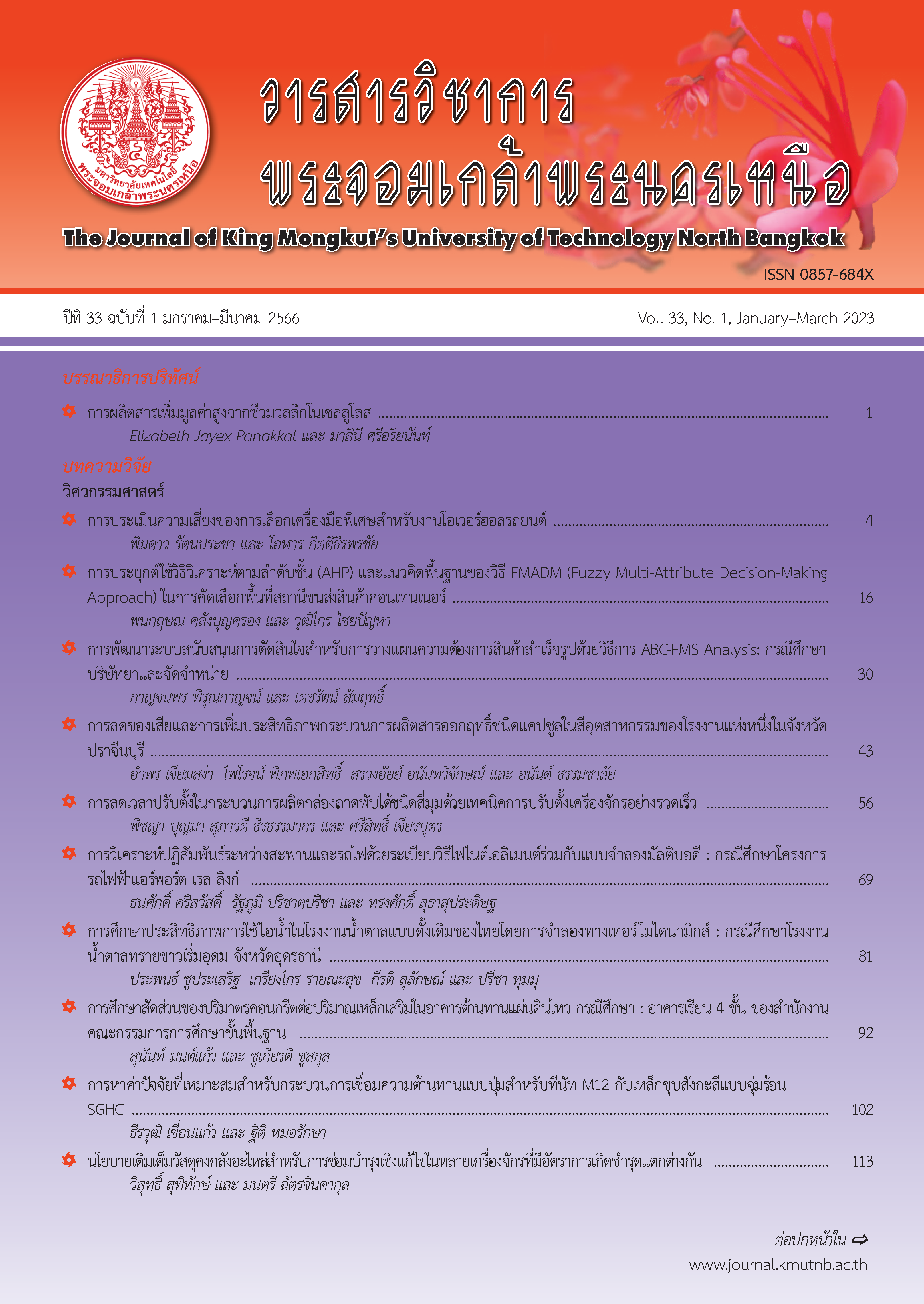พฤติกรรมการรับแรงเฉือนตรงของทรายผสมเศษยางรถยนต์
Main Article Content
บทคัดย่อ
งานวิจัยฉบับนี้เป็นการทดสอบคุณสมบัติพื้นฐานและศึกษาพฤติกรรมการรับแรงเฉือนตรงของทรายผสมเศษยางรถยนต์ โดยเป็นการทดสอบดินทรายซิลิกาผสมเศษยางรถยนต์ขนาด 2 mesh ดินทรายซิลิกาและดินทรายแม่น้ำผสมเศษยางรถยนต์ขนาด 20 mesh ในสถานะความหนาแน่นแบบหลวมและแบบแน่น ด้วยอัตราส่วนผสม 5, 15 และ 25% โดยน้ำหนัก ผลการทดสอบค่าความถ่วงจำเพาะและความหนาแน่นแห้งของดินทรายผสมเศษยางรถยนต์จะมีค่าลดลงเมื่อปริมาณส่วนผสมของเศษยางรถยนต์เพิ่มขึ้น ผลการทดสอบแรงเฉือนโดยตรงพบว่ากำลังรับแรงเฉือนและค่ามุมเสียดทานภายในของเม็ดดินของดินทรายผสมเศษยางรถยนต์มีแนวโน้มลดลงเมื่ออัตราส่วนผสมของเศษยางรถยนต์เพิ่มมากขึ้นโดยมีพฤติกรรมการรับแรงเฉือนสุดท้าย และในส่วนผสมที่ดินทรายมีรูปร่างเม็ดดินลักษณะเป็นเม็ดเหลี่ยมและมีสภาพแน่น มีแนวโน้มในการลดลงของกำลังรับแรงเฉือนและมุมเสียดทานภายในมากกว่าดินทรายที่มีรูปร่างมนกลมในสภาพหลวม ในกรณีที่ความเค้นปกติตามแนวดิ่งที่กระทำกับตัวอย่างดินทรายผสมเศษยางรถยนต์มีค่าสูงมากค่ากำลังรับแรงเฉือนสุดท้ายมีแนวโน้มลดลงอย่างชัดเจนตามปริมาณเศษยางรถยนต์ที่เพิ่มขึ้นโดยเฉพาะอย่างยิ่งในตัวอย่างดินสภาพแน่นและหากขนาดของเศษยางรถยนต์ที่ผสมในตัวอย่างดินทรายมีขนาดใหญ่ขึ้น กำลังรับแรงเฉือนของตัวอย่างดินในสภาพหลวมมีแนวโน้มลดลง ในทางตรงกันข้ามกำลังรับแรงเฉือนของตัวอย่างดินสภาพแน่นมีแนวโน้มเพิ่มมากขึ้น ในส่วนของพฤติกรรมของความเครียดเชิงปริมาตรของตัวอย่างดินทรายผสมเศษยางรถยนต์ทั้งในสภาพหลวมและสภาพแน่นมีแนวโน้มในการหดตัวค่อนข้างมาก
Article Details

อนุญาตภายใต้เงื่อนไข Creative Commons Attribution-NonCommercial-NoDerivatives 4.0 International License.
บทความที่ลงตีพิมพ์เป็นข้อคิดเห็นของผู้เขียนเท่านั้น
ผู้เขียนจะต้องเป็นผู้รับผิดชอบต่อผลทางกฎหมายใดๆ ที่อาจเกิดขึ้นจากบทความนั้น
เอกสารอ้างอิง
The Office of Industrial Economics (2020, Dec.). Industrial statistic (e-Statistic): The production of tyre and tyre tube (local and export distribution in 2019) [Online] (in Thai). Available:https:// indexes.oie.go.th/industrialStatistics1.aspx
S. Youwai and D. T. Bergado, “Strength and deformation characteristics of shredded rubber tire – sand mixtures,” Canadian Geotechnical Journal, vol. 40, no. 2, pp. 254–264, 2003.
E. Masad, R. Taha, C. Ho, and T. Papagiannakis, “Engineering properties of tire/soil mixtures as a lightweight fill material,” Geotechnical Testing Journal, vol. 19, no. 3, pp. 297–304, 1996.
S. Kawata, M. Hyodo, R. P. Orense, S. Yamada, and H. Hazarika, “Undrained and drained shear behaviour of sand and tire chips composite material,” Scrap Tire Derived Geomaterials- Opportunities and Challenges,” in Proceedings IW-TDGM, 2007, pp. 277–284.
M. N. Sheikh, M. S. Mashiri, J. S. Vinod, and H. H. Tsang, “Shear and compressibility behaviours of sand–tyre crumb mixtures,” Journal of Materials in Civil Engineering, vol. 25, no. 10, pp. 1366–1374, 2013.
I. Ahmed, “Laboratory study of properties of rubber-soils,” Indiana Department of Transportation, Joint Highway Research Project, Purdue Uni., West Lafayette, IN. Final Rep. FHWA/IN/JHRP-93/4, May 1993.
T. B. Edil and P. J. Bosscher, “Engineering properties of tire chips and soil mixtures,” Geotechnical Testing Journal, vol. 17, no. 4, pp. 453–464, 1994.
N. Tatlisoz, T. B. Edil, and C. H. Benson, “Interaction between reinforcing geosynthetics and soil tire chip mixtures,” Journal of Geotechnical and Geoenvironmental Engineering, vol. 124, no. 11, pp. 1109–1119, 1998.
Standard Test Methods for Specific Gravity of Soil Solids by Water Pycnometer, ASTM D854- 14, 2014.
R. Whitlow, “Basic physical properties of soils,” in Basic Soil Mechanics, 3rd ed. Essex, England, 1995, ch. 3, pp. 45–70.
H. J. Alaa and Al-Rkaby, “Strength and deformation of sand-tire rubber mixtures (STRM): An experimental study,” Studia Geotechnica et Mechanica, vol. 41, no. 2, pp. 1–7, 2019.
D. T. Bergado, T. Tanchaisawat, P. Voottipruex, and T. Kanjananak, “Reinforced lightweight tire chips-sand mixtures for bridge approach utilization,” Scrap Tire Derived Geomaterials- Opportunities and Challenges,” in Proceedings IW-TDGM, 2007, pp. 45–58.
J. H. Lee, R. Salgado, A. Bernal, and C. W. Lovell, “Shredded tires and rubber-sand as lightweight backfill,” Journal of Geotechnical and Geoenvironmental Engineering, vol. 125, no. 2, pp. 132–141, 1999.
M. S. Mashiri, J. S. Vinod, M. N. Sheikh, and H. H. Tsang, “Shear strength and dilatancy behaviour of sand– tyre chip mixtures,” Soils and Foundations, vol. 55, no. 3, pp. 517–528, 2015.

